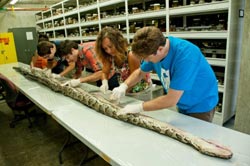UF scientists find state record 87 eggs in largest python from Everglades

On Aug. 10, 2012, researchers at the Florida Museum of Natural History on the University of Florida campus examine the internal anatomy of the largest Burmese python found in Florida to date. The 17-foot-7-inch snake weighed 164 pounds and carried 87 eggs in its oviducts, a state record. Following scientific investigation, the snake will be mounted for exhibition at the museum for about five years, and then returned for exhibition at Everglades National Park. Pictured are Rebecca Reichart (from left), Leroy Nunez, Nicholas Coutu, Claudia Grant and Kenneth Krysko.<br>
Scientists at the Florida Museum of Natural History on the UF campus examined the internal anatomy of the 164.5-pound snake Friday. The animal was brought to the Florida Museum from Everglades National Park as part of a long-term project with the U.S. Department of the Interior to research methods for managing the state’s invasive Burmese python problem. Following scientific investigation, the snake will be mounted for exhibition at the museum for about five years, and then returned for exhibition at Everglades National Park.
“This thing is monstrous, it’s about a foot wide,” said Florida Museum herpetology collection manager Kenneth Krysko. “It means these snakes are surviving a long time in the wild, there’s nothing stopping them and the native wildlife are in trouble.”
Krysko said the snake was in excellent health and its stomach contained feathers that will be identified by museum ornithologists. Burmese pythons are known to prey on native birds, deer, bobcats, alligators and other large animals.
“A 17.5-foot snake could eat anything it wants,” Krysko said. “By learning what this animal has been eating and its reproductive status, it will hopefully give us insight into how to potentially manage other wild Burmese pythons in the future. It also highlights the actual problem, which is invasive species.”
Native to Southeast Asia and first found in the Everglades in 1979, the Burmese python is one of the deadliest and most competitive predators in South Florida. With no known natural predator, population estimates for the python range from the thousands to hundreds of thousands. They were determined to be an established species in 2000 and are a significant concern, Krysko said.
“They were here 25 years ago, but in very low numbers and it was difficult to find one because of their cryptic behavior,” Krysko said. “Now, you can go out to the Everglades nearly any day of the week and find a Burmese python. We’ve found 14 in a single day.”
The rapid population growth led to recent state laws prohibiting people from owning Burmese pythons as pets or transporting the snakes across state lines without a federal permit. Florida residents also may hunt pythons in certain wildlife management areas during established seasons with a hunting license and required permits.
Everglades National Park and the Florida Fish and Wildlife Conservation Commission are partnering with other agencies to address the increasing populations.
Skip Snow, a park wildlife biologist, said research of the snake’s biology is important for understanding how to curtail the future spread of invasive species.
“I think one of the important facts about this animal is its reproductive capability,” Snow said. “There are not many records of how many eggs a large female snake carries in the wild. This shows they’re a really reproductive animal, which aids in their invasiveness.”
Non-native species are considered invasive if they have a negative impact on native species or habitat, cause economic damage or pose a threat to human health and safety. Exotic snakes found in Florida are often the result of pet owners accidentally or intentionally releasing the animals. Citizens may dial 1-800-IVE-GOT1 to receive removal assistance by trained handlers.
Previous records for Burmese pythons captured in the wild were 16.8 feet long and 85 eggs.
“I’m really happy to be part of this team of researchers working on the Burmese python problem in Florida, and have been for a number of years,” Krysko said. “But when I’m able to conduct this type of research here at the university, I’m able to teach new students and new researchers about python anatomy and discuss the problem with invasive species. We need all the help we can get, we really do.”
Florida has the world’s worst invasive reptile and amphibian problem. Krysko led a 20-year study published in September 2011 in Zootaxa showing 137 non-native species were introduced to Florida between 1863 and 2010. The study verified the pet trade as the No. 1 cause of the species’ introductions and the Burmese python was one of 56 non-native species determined to be reproducing and established in the state.
Credits
Writer
Danielle Torrent, dtorrent@flmnh.ufl.eduMedia
Contact
Paul Ramey, pramey@flmnh.ufl.edu, 352-213-0999
Source
Rob Robins, rhrobins@flmnh.ufl.edu, 352-273-1957
Media Contact
More Information:
http://www.ufl.eduAll latest news from the category: Life Sciences and Chemistry
Articles and reports from the Life Sciences and chemistry area deal with applied and basic research into modern biology, chemistry and human medicine.
Valuable information can be found on a range of life sciences fields including bacteriology, biochemistry, bionics, bioinformatics, biophysics, biotechnology, genetics, geobotany, human biology, marine biology, microbiology, molecular biology, cellular biology, zoology, bioinorganic chemistry, microchemistry and environmental chemistry.
Newest articles

Innovative 3D printed scaffolds offer new hope for bone healing
Researchers at the Institute for Bioengineering of Catalonia have developed novel 3D printed PLA-CaP scaffolds that promote blood vessel formation, ensuring better healing and regeneration of bone tissue. Bone is…

The surprising role of gut infection in Alzheimer’s disease
ASU- and Banner Alzheimer’s Institute-led study implicates link between a common virus and the disease, which travels from the gut to the brain and may be a target for antiviral…

Molecular gardening: New enzymes discovered for protein modification pruning
How deubiquitinases USP53 and USP54 cleave long polyubiquitin chains and how the former is linked to liver disease in children. Deubiquitinases (DUBs) are enzymes used by cells to trim protein…



